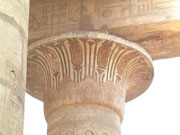TOUR NEWS -
RECONNAISANCE OF JORDAN AND SYRIA FOR OUR UPCOMING TOUR APRIL 2010
RECONNAISANCE OF JORDAN AND SYRIA FOR OUR UPCOMING TOUR APRIL 2010
In April I joined up with Ian Casey, Diane Casey and Bob Snow for a �recky� of Jordan and Syria in preparation for the upcoming �B.C. Archaeology� tour of the region in 2012. We spent 10 days in Jordan and 18 days in Syria exploring the archaeology and the history of the area - it has been a few years since I have been to these two countries and I noticed how much they have changed and become more prosperous.
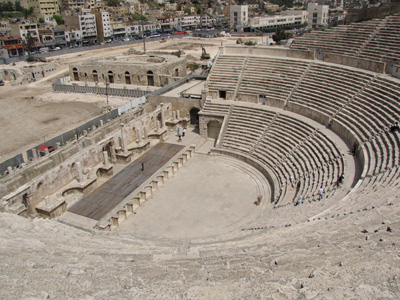 |
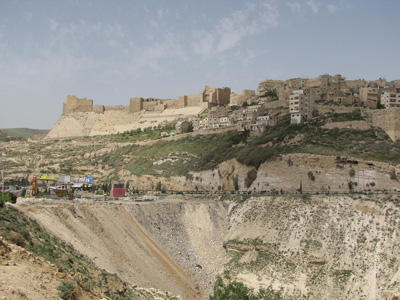 |
The Roman theatre in Amman |
The Crusader Castle at Kerak |
We spent the first few days in Amman, the capital of Jordan, exploring the city and the local region. We visited the �Acropolis� with its Roman era Temple to Hercules, the palace of the Umayyad rulers of the 8th Century AD, and the fascinating archaeological museum with finds from the Neolithic onwards - this museum will soon be supplanted by a wonderful new building which will be state of the art. After lunch we saw the Roman theatre and ethnographic museum. The following day we saw the fascinating �Desert Castles� in the desolate country to the east of Amman which included caravanserais, painted bath houses, and the brooding black-stone Asraq Castle where Laurence of Arabia prepared for his attack on Damascus.
The following day we headed west to the Jordan River where we saw the traditional site of the baptism of Christ - we had a swim in the Dead Sea, experiencing the strange sensations of floating on the surface. We then drove up to Mt Nebo where we saw the basilica ruins and from there to Madaba to see the wonderful mosaics, including the famous �Madaba Map�, a Byzantine representation of the Holy Land. Our journey then took us down the �King�s Highway� through rolling green hills to Kerak Castle, one of the most impressive Crusader Castles in the region with a sheer drop on almost every side. From here we continued down to Shobak, the site of another very impressive 12th Century Castle. The most astonishing aspect of the defence of the castle is the water tunnel which leads down hundreds of steps into the gloom.
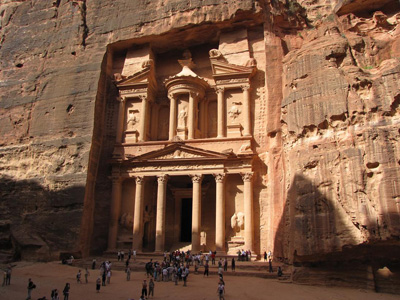 |
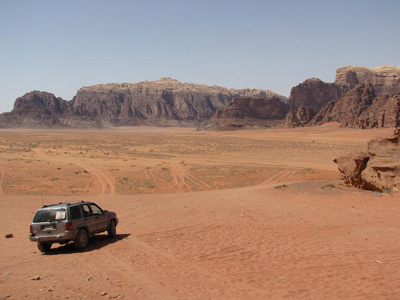 |
The �Treasury� at Petra |
Exploring Wadi Rum |
The next three days were spent in Petra and the surrounding region. We thoroughly explored every stone and rock-cut structure in the area, and photographed it from every angle too! On the first day we walked down through the siq (a narrow gorge winding down to the valley), the first site of the �Treasury� being a real treat. Almost as impressive as this magnificent rock-cut mortuary chapel was the presence of a cafe nearby which served real coffee! We then explored the numerous rock-cut chapels and a splendid church with mosaics before climbing into and around all the �Royal Tombs� carved into the impressive rock-face. In the evening we re-entered Petra, walking down the siq which was illuminated by candles. The sight of the �Treasury� illuminated in the gloom, and the sound of music and singing was a real treat.
The next day we entered Petra again and then ascended via a winding path to the �High Place�, a rock-cut altar overlooking the main valley and with superb views of the local area. The climb was not at all difficult and well worth the effort - the descent on the other side of the hill revealed numerous tomb chapels and some rare examples of Nabatean inscriptions on the rock faces. We then explored the Great Temple, a very grand building in the centre of the site - in the afternoon we ascended to the incomparable Deir, a stupendous rock-cut mortuary chapel carved at the top of a mountain overlooking the Wadi Araba. We decided to ride donkeys to the summit and this was an experience in itself as there was often a precipitous drop on one side of the path as we made our ascent. The experience and views were wonderful and the Deir is definitely one of the highlights of any trip to the Middle East.
Our journey then took us to �Little Petra�, a smaller caravanserai to the north of the main site. We explored the trading station and then headed south for a day in the Wadi Rum. We saw the impressive Nabatean temple site and went for a walk to the local spring which has created a lush oasis in the desert. Our 4-wheel drive then took us out into the deep desert to experience the grandeur of this wild place. We climbed up an isolated outcropping for a stunning view over the desert valley, and also explored an isolated water-carved gorge. The visit to Rum was a magnificent experience, the towering desert cliffs creating a stark backdrop to the desert valley.
The following day we headed back to Amman and then went north to explore some of the archaeological sites of the region near the Jordan River. Our first stop was at the magnificent site of Jerash, one of the best preserved Roman cities in the Near East - much of the ancient city is visible and we explored the superb theatre, the colonnaded streets and the Temple of Artemis. We also saw the ruins of the site of Pella which has a well preserved Christian basilica and ancient Canaanite Temple from the Bronze Age. We then headed to Ajlun Castle, one of the most impressive Crusader era castles - built in Arab style rather than European, it was fascinating to explore the multiple levels of the castle and its many rooms. Our day ended with a visit to Umm Qais, a Roman era city overlooking the Golan Heights and the Sea of Galilee - the black basalt theatre and ruined agora were fascinating remnants of an era when this region lay under Roman control.
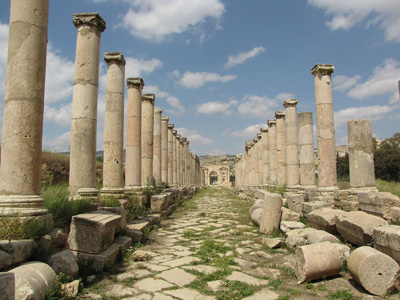 |
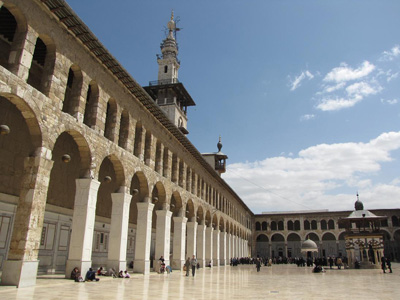 |
The ruins of Jerash |
The Great Mosque in Damascus |
We spent a night in the northern Jordanian town of Irbid and the following morning we crossed the border into Syria. The process was surprising quick and easy. We then headed to the nearby Roman site of Bosra, one of the most important ancient sites of the region of the Hauran. The highlight of the visit was the remarkably well preserved Roman theatre which still retains much of its original stage structure - the ruins of the city were also impressive and included bathhouse, houses and cisterns. We headed north and checked into our hotel in Damascus.
Damascus is a fascinating city which retains a rich heritage from its mediaeval past. The base of the 8th Century Umayyad Dynasty it acquired many splendid buildings and would become one of the great market cities of the region. We spent our first day exploring the Old City with time in the wonderful Great Mosque. Richly decorated with mosaics showing scenes of gardens and cities, it is very much a living mosque with numerous Iranian pilgrims coming to visit the Shiite shrines. We explored the prayer hall and nearby tomb of Saladin, before venturing into the Old City and wandering the many covered streets with exotic stalls. In the afternoon we explored the Azem Palace, a magnificent Ottoman period residence of the provincial Governor.
A day trip out of Damascus took us to the Hauran district, a plateau region to the south of Damascus which is dominated by black basaltic outcrops and numerous volcanic cones. We saw a number of interesting archaeological sites in the area including Shahba, the home town of the Roman Emperor Philip the Arab who created a short-lived provincial capital here. The bathhouse is particularly well preserved. We also saw the ruins of the Roman era city of Kanawat with its impressive civic structures, cisterns and theatre.
Our trip then took as east through an increasingly stark and desert landscape to the Oasis town of Palmyra - en route we stopped at the Baghdad cafe for a later breakfast. The oasis of Palmyra, home of the tragic Queen Zenobia, was a major trading post for exotic products including spice and incense and developed as a major urban centre. We explored the stupendous Temple of Bel with its fascinating relief decoration and then went to the site museum with its excellent collection of sculpture. In the evening we went by car to the Crusader Castle overlooking the site for a wonderful desert sunset - cocktails made a splendid addition to the event.
The following day we explored the rest of the ruins of Palmyra - the site is extensive and includes a number of temples, a theatre and the legionary camp of Diocletian. The sunset, with the backdrop of the �tetra-pylon� gateway in the centre of the city, was magnificent! Before leaving the area we explored the famous �tower tombs� from the Nabatean period (1st and 2nd Centuries AD). We ascended some of these impressive family mausolea which contain numerous niches for the burials - a superb view over the ruins was worth the effort.
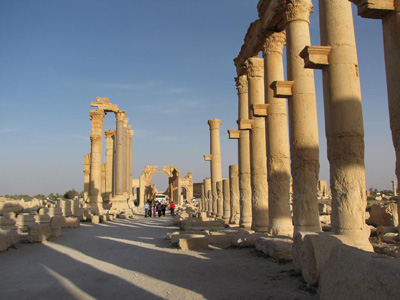 |
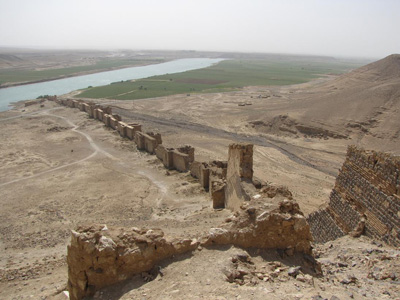 |
The ruins of Palmyra at sunset |
The impressive fortifications at Halibiya |
Our trip next took us eastwards towards the Euphrates River across the open desert. En route we stopped to see the impressive Umayyad era fortress of Qasr el-Heir. Built to guard the region and facilitate trade, the castle looms out of the desert and is visible from far afield. We then continued our journey, arriving in Deir Ez-Zor on the Euphrates where we checked into our hotel. Our journey the following day took us along the river towards the Iraqi border in order to see the archaeological remains of Dura Europos and the Middle Bronze Age site of Mari. Dura is surrounded by impressive Late Roman walls and preserves fascinating evidence of its siege by the invading Sassanid Persian in the mid 3rd Century AD. The view over the Euphrates from the citadel is dramatic. The mudbrick palace of Zimri-Lim at Mari is one of the best preserved relics from this early age.
We left Deir ez-Zor and headed up the Euphrates to the stunning site of Qasr Halabiya, a formidable walled city constructed by the Byzantine Emperor Justinian to guard the narrow passage of the Euphrates. The walls of the city, and the legionary headquarters called the praetorium, are well worth a visit. We then continued NW, stopping to see the remains of the ancient fortified city of Resafa - constructed in a wide desolate landscape, the inhabitants ensured their survival by enormous underground cisterns.
Our next few days were spent in the fascinating medieval walled city of Aleppo and the surrounding area. This fascinating walled city still preserves a sense of the ancient and mysterious as you walk through many kilometres of roofed markets. The Great Mosque is more refined than the one in Damascus. We explored the side lanes of the city including the beautiful maristan or hospital complex. The spectacular fortress in the centre of the city, built on top of the ancient tell site, offers an stunning view over the city and surrounding countryside.
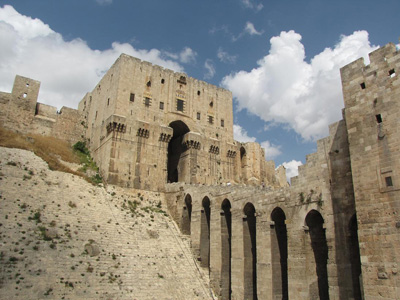 |
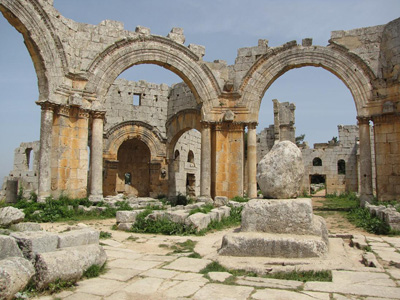 |
The fortress in Aleppo |
The basilica of St Simeon |
A day trip out of Aleppo took us north to the site of St Simeon basilica - located on a hill with a stunning view over the Amuq plain, this 5th Century structure is very well preserved. From here we headed further north, towards the Turkish border, where we saw the remains of the Neo-Hittite temple at Ain Dara - the local authorities have uncovered an early Iron Age cultic site with images of lions and kings carved into the surrounding temple base.
The Museum in Aleppo is superb, with an excellent collection of artefacts from the region - and you can never get enough of exploring the lanes and alleys of the old city. But our route now headed southwards and we made our way to Hama on the Orontes River. On the way we stopped to see the impressive Bronze Age remains of Ebla - finds from the site included an extensive library of cuneiform tablets which have added considerably to our knowledge of the region. We also saw the broad colonnaded streets of the Roman city of Apamea, located in a dramatic landscape overlooking the Orontes River Valley. In Hama we explored the famous mediaeval waterwheels which lifted water from the river. We also enjoyed our visit to the Azem Palace, provincial home of the Ottoman era Governor.
Our journeys then lead us towards the NW and the mountains of western Syria. We passed up the Orontes River Valley, ascending over the ridge until we came to the stunning Crusader Castle known as Qalaat Saladin. Built in the 12th Century by Crusader Knights, it was taken by the Muslim ruler Saladin after a protracted siege. Situated at the summit of an isolated rocky hill, the castle could be approached by crossing a drawbridge supported by an isolated pillar of rock. The main keep is very well preserved and still has its cisterns. From here we headed down the coast and visited the impressive remains of the Late Bronze Age city of Ugarit. The palace of the ruler is very well preserved, as are the walls and gates, giving a splendid impression of this important port city.
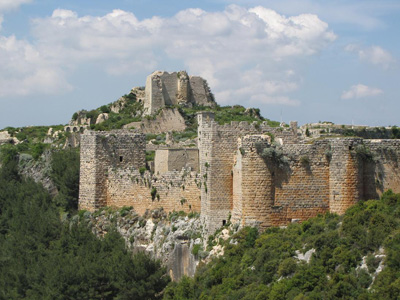 |
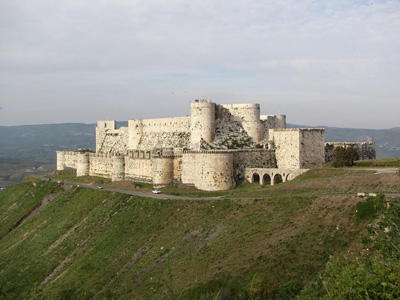 |
Qalaat Saladin - a superb castle |
Krak de Chevaliers Castle - amazing! |
We next headed south along the coast, stopping for the morning at the impressive Crusader Castle at Marqab. Located on a hill dominating the coastal plain, the black-stone castle is very well preserved and gives a wonderful sense of life in a castle of this period. The chapel is undergoing a restoration and will be magnificent. We continued on to Tartus where we saw the local Museum and fort before stopping to see the Canaanite altar at Amrit. We continued on to Krak de Chevaliers which would be our base for a few days.
Krak de Chevaliers is famed for its stunning location and excellent preservation - a walk around the walls gives an impression of strength which could barely be equalled. Another Crusader structure built in the 12th Century it controlled the Homs Pass which leads from the coast to the interior. The Great Hall and the Chapel are superb examples of Gothic architecture and all parts of the castle are almost completely preserved. We enjoyed a couple of visits at different times of day, the castle glowing in the late afternoon light. We explored the local region around the castle, looking at the stark remains of the Assassin�s Castle at Masyaf and the mediaeval keep at Safita.
Our journey ended in Damascus - en route we stopped to see the mound of the ancient city of Qadesh on the Orontes River, scene of the famous battle fought by Ramesses II against the Hittite Emperor Muwatallis around 1290 BC. The landscape really came alive as we recalled the events described by the famous Egyptian pharaoh. In Damascus we explored more of the ancient walled city, including the citadel and a number of wonderful Ottoman houses, many of which are being converted into boutique hotels. We also enjoyed a visit to the National Museum. Our four weeks of travel in the region certainly gave us an appreciation of the splendid and rich history of the area.
Michael Birrell
